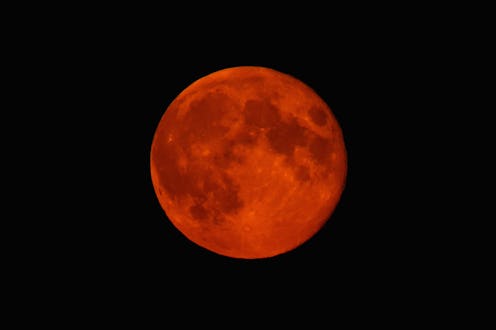Life
This Month’s Full Moon Is Actually Going To Be Pretty Rare

While you might argue that every full moon is a special event, July's full moon is undeniably ~extra~ special. The July 2018 Buck Moon is a blood moon, and that's a double whammy that doesn't happen all that often. So some of us should consider ourselves #blessed to be able to see it. But to understand why this combination of lunar condition is rare and not visible to all, you'll need to understand what factors create the conditions themselves — so let's break it down, shall we? (Imagine that I am currently transforming into The Magic School Bus' Miss Frizzle and welcoming you to a school bus that's been transformed into a kind of run-down rocket ship. Thanks.)
July's full moon was named the Buck Moon by the Algonquin tribes who used it as a reminder that male deer would be starting to grow back their antlers. Once a year, bucks shed their antlers, and come July the antlers start to grow back. The process of regrowth takes the remainder of the summer, but the Algonquin tribes liked to keep track of the deer as they were a big source of food, clothing, and other supplies for them. While the buck moon has nothing to do with the sight of the moon, full moons in general were used as a light source for tribes to travel, hunt, or gather by. The tribes saw the moons as calendars, so they always associated the July full moon with the beginning of antler season and would plan accordingly. That said, if there was a blood moon that was visible to them, it would hinder the tribe's visibility as it would be far duller than the average full moon, on account of its rusty coloring. So while a blood moon might be a cool sight for us to see and great content for our Instagram accounts, it would have meant something completely different to the historic tribes.
The rusty coloring brings us to the other notable lunar condition: the blood moon. A blood moon occurs in a lunar eclipse. When the moon passes into Earth's shadow, it takes on a rusty or reddish coloring, which is what historically gave it the name. While you might think of an eclipsed moon as blacked-out, it's actually this color because some of the sunlight that goes through our atmosphere is bent around the sides of the planet. That bent light, in addition to the fact that red lights have longer wavelengths (which mean they're more likely to penetrate the atmosphere), make the moon look, well, bloody.
As far as visibility goes, July's full moon will only look reddish to viewers in Africa, the Middle East, parts of central Asia, eastern South America and Australia. Basically, if you're watching for the blood moon from the U.S., you'll miss the eclipse entirely. The "blood moon" aspect of July's full moon is only a condition that parts of the world will see.
But this brings me to my next point: the blood moon is a special sight. The next time we'll have a lunar eclipse that creates a blood moon will occur Jan. 21, 2019. But the good news is that we'll be able to get a great view of this blood moon in the U.S., especially on the West Coast. After that, we'll have to wait until Jul. 16, 2019, when we get the opportunity to view a partial lunar eclipse and partial blood moon.
The next time we'll have a total lunar eclipse will be on May 26, 2021, and after that, not again until May 15, 2022. So yeah, it's pretty rare, and what's more, it's even rarer to have the lunar eclipse spectacles fall into your own viewing area.